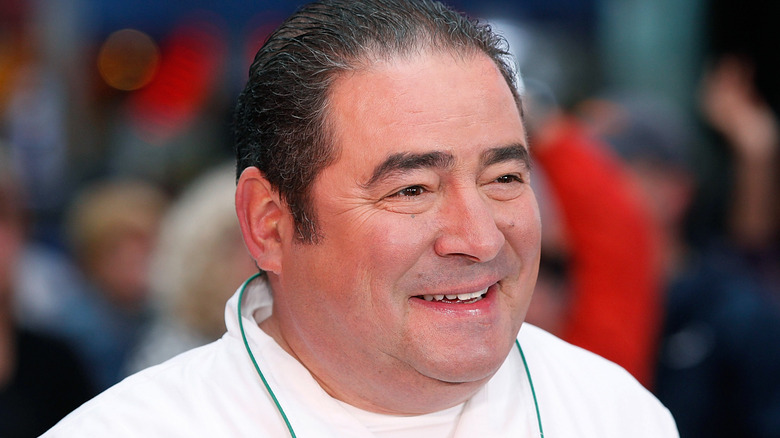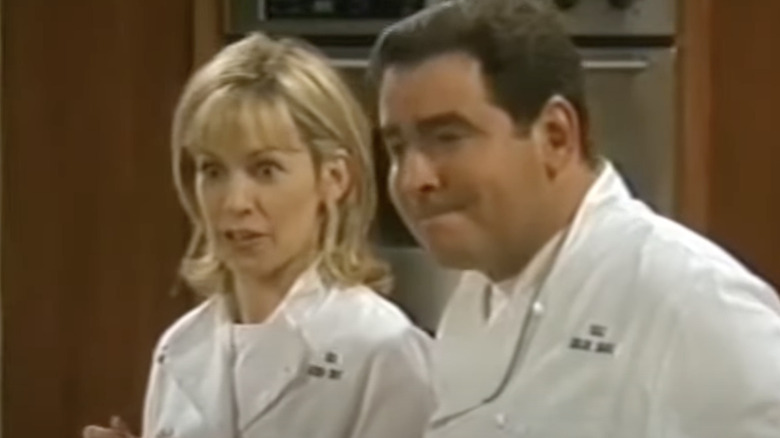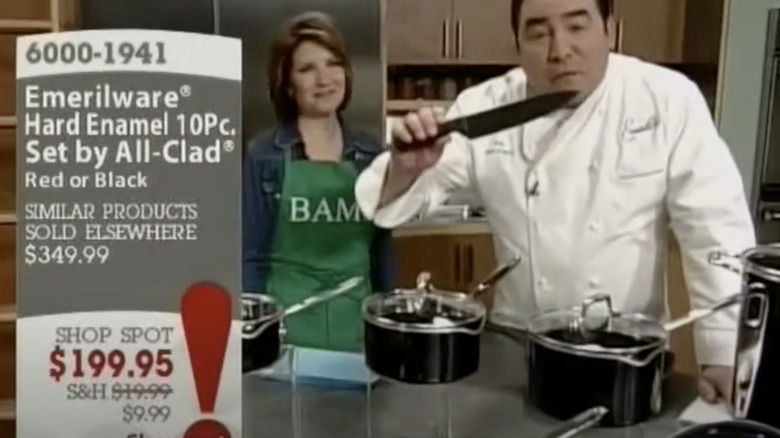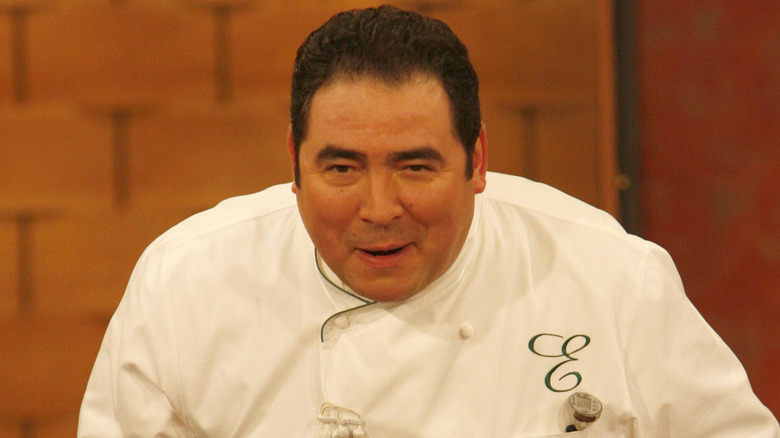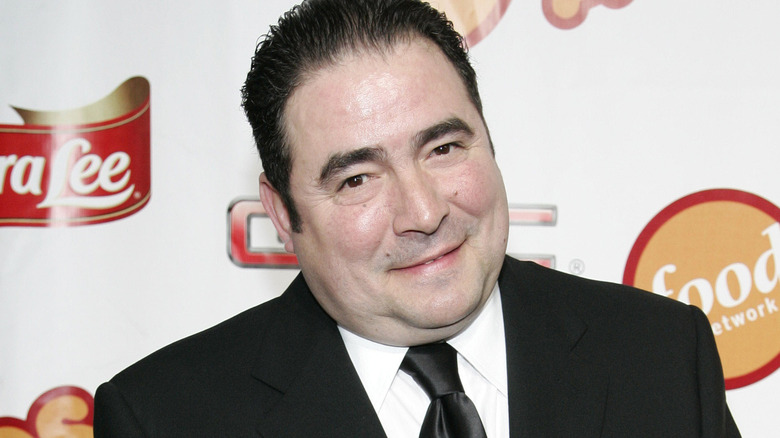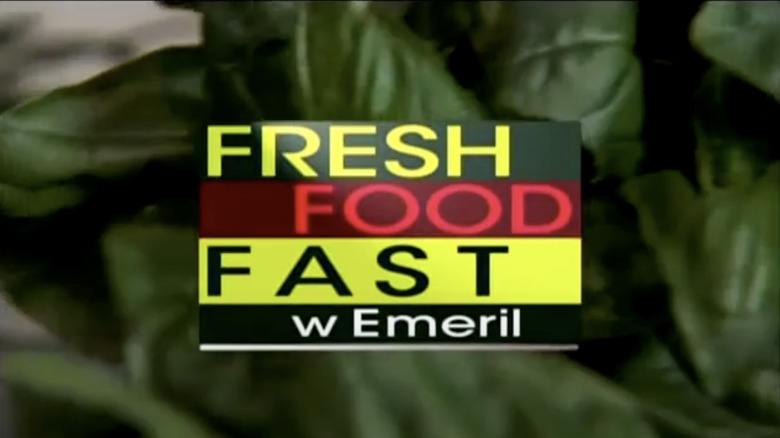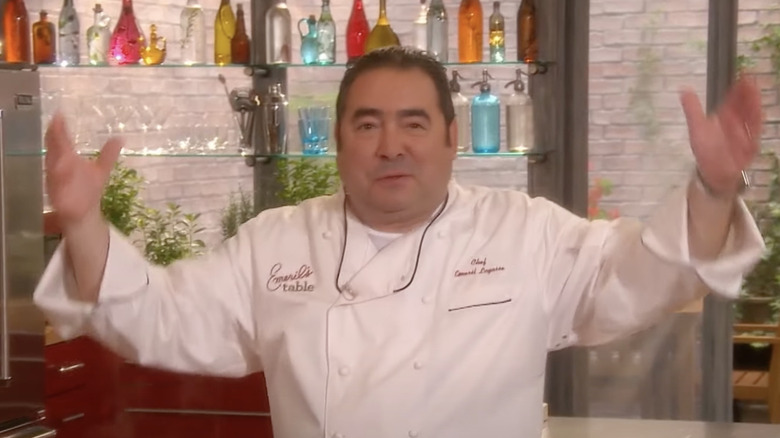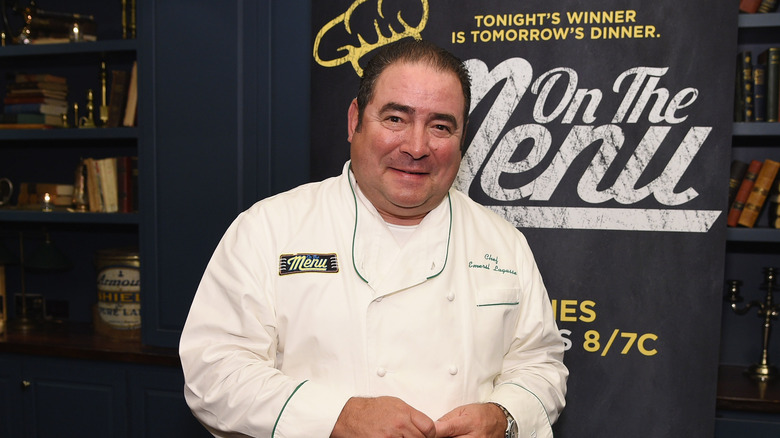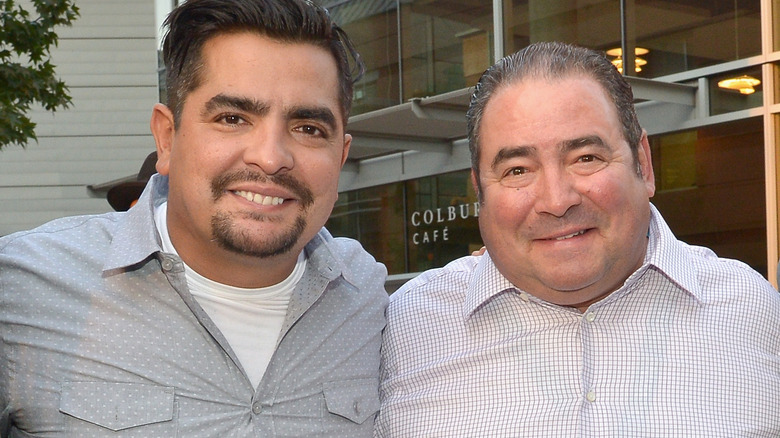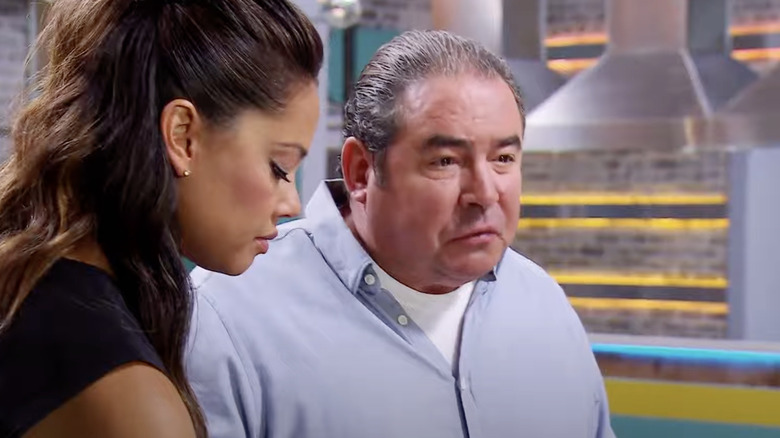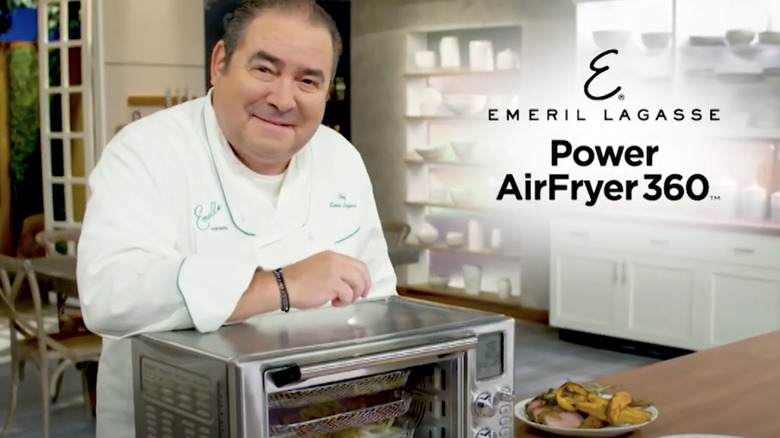The Forgotten Failures Of Emeril Lagasse
Emeril Lagasse has been such a warm, likable, and knowledgeable chef, food TV personality, and restaurateur for so long and with so much success that it's hard to believe he didn't hit big with every venture he's attempted. Lagasse — from his Food Network shows in the 1990s to countless appearances on other food TV shows to his cookbooks, "Emeril" branded products, and portfolio of restaurants — grew into a cultural phenomenon. As Lagasse built his empire, he recognized how to spice up a cooking show, like shouting "Bam!" when adding some heat to a classic Creole dish on "Emeril Live" (one of the best Food Network shows of all time) or bantering with other chefs or a studio audience.
Lagasse's encyclopedic fascination of food is unparalleled and so is his joy for cooking and sharing food with friends and fans. In capitalizing on the chef's enduring popularity, TV producers and companies may have overextended and overexposed the icon. The result: Lagasse has made so many TV shows and launched so many products that some just couldn't get that "bam!" from the rest of the world. A few of these endeavors were such flops that they're largely forgotten years after they came and went. Let's kick it down a notch with a look at these uncharacteristic failures in the career of Lagasse.
Emeril
TV creator-producers Harry Thomason and Linda Bloodworth-Thomason, best known for "Designing Women" and "Evening Shade," thought they had another hit on their hands in the early 2000s with "Emeril," a sitcom starring Emeril Lagasse as a loosely fictionalized version of himself. Lagasse was cool to the idea, as he didn't think he possessed the requisite acting skills to anchor a scripted comedy. ABC, where Lagasse regularly appeared on "Good Morning America" with a cooking segment, declined to broadcast "Emeril."
Newly installed NBC Entertainment president Jeff Zucker had tried unsuccessfully to poach Lagasse for his network's morning show, "Today" and ended up ordering a pilot of the sitcom. After NBC executives and a handful of TV critics derided the show, which consisted primarily of Lagasse interacting with a wife and kids, the Thomasons reworked "Emeril" to put the chef in his element — it became a backstage comedy about the production of a TV cooking show. In the version of "Emeril" that actually aired on NBC, the family element was dumped, and TV veterans Robert Urich and Carrie Preston joined the cast as Lagasse's agent and a food stylist, respectively.
Fans of Lagasse's cable cooking shows did not follow the chef to a narrative network sitcom. After horrendous reviews and low ratings, "Emeril" was canceled by NBC after seven episodes aired in the fall of 2001. It would finish the season as the 82nd-most-watched show on network television.
From Emeril's Kitchen
Emeril Lagasse launched many products bearing his first name as its brand, including kitchenware and a spice blend called Emeril's Original Essence. Media company Scripps, which owned Food Network in the mid-2000s, placed Lagasse at the center of a show on another outlet it owned, the Shop at Home Network. A structured program on this home shopping channel, "From Emeril's Kitchen" featured Lagasse cooking a little while mostly hawking products and gadgets that had his name on them and that viewers could order right then and there by calling a toll-free number.
Former Food Network chief Judy Girard was named president of Shop at Home in 2004, when Scripps bought the interactive retail outlet. "This was the vision from the beginning," Girard said in a press release, meaning that plans were long in place to extend Lagasse's media reach past Food Network to Shop at Home. In addition to a weekly series, the home shopping channel contracted with Lagasse to make occasional specials.
After about a year of Lagasse appearing in weekly episodes of the advertisements disguised as television programs, Scripps canceled the series. That's because Scripps completely shut down the Shop at Home Network in 2006, leading to an end of all programming — "From Emeril's Kitchen" couldn't save the channel or itself.
The reworked Emeril Live
Food Network went live in 1993, and Emeril Lagasse joined the operation shortly thereafter. His cooking show "Essence of Emeril" debuted in 1995 while "Emeril Live" premiered in 1997. Airing weeknights in primetime, "Emeril Live" resembled a late-night talk show, but food-focused. Along with live music and guests, the show featured Lagasse exuberantly cooking for a studio audience that cheered whenever he said "Let's kick it up a notch!" or "Bam!"
After a 2004 study suggested that viewers wanted programming beyond the standard cooking show format, Food Network spent hundreds of thousands of dollars to revamp "Emeril Live," building a new set with high-end equipment, cutting Lagasse's show-starting monologue and bringing in guest chefs and emerging rock bands. Food Network was after a younger audience favored by advertisers, the ones watching Bravo's "Top Chef" and its own "Good Eats" and "Iron Chef America."
None of the superficial and structural changes worked. The audience for "Emeril Live," one of Food Network's costliest shows to produce, gradually shrunk and remained older. Executives asked Lagasse to be a regular contestant on "Iron Chef America," theorizing that he'd attract new fans to "Emeril Live." Lagasse said no to the offer, while his agent, Jim Griffin, asked Food Network to make "Emeril Live" appeal to a different demographic entirely — families — by inviting guests like Elmo from "Sesame Street." With nothing helping the slow demise of "Emeril Live," Food Network canceled the series (as well as "Essence of Emeril") in late 2007.
Food Network Awards
In the 2000s, various cable channels generated event programming and self-promotion by staging their own awards shows. Adding to the list that also included the MTV Video Music Awards, the Spike Guys Choice Awards, and the Nickelodeon Kids' Choice Awards came the Food Network Awards. The first ceremony was taped at the Food Network South Beach Wine and Food Festival in February 2007 and aired that April, hosted by the programmer's biggest star at the time and the personality most associated with the network: "Emeril Live" host Emeril Lagasse. The chef presided over the event as the Master of Ceremonies, introducing presenters and handing out awards himself. Many of the prizes were chosen by Food Network viewers, including Favorite Comfort Food Combo, Best Ball Park Eats, and Favorite Coolest Cocktail.
Even though Food Network trotted out all of its stars for the celebration and the broadcast, with Lagasse headlining the whole thing, it wasn't a successful venture for the channel. The 2007 Food Network Awards was a singleton — the event was never held again, with or without Lagasse.
The Emeril Lagasse Show
The last episodes of a revamped "Emeril Live" aired on Food Network in December 2007, ending a 10-year run of what was once the channel's trademark show. Just over two years later, another network attempted to revive the series but with a few tweaks. Ion Television, a little-watched, over-the-air general entertainment channel, debuted one of its few original, non-narrative programs in March 2010. "The Emeril Lagasse Show" was taped in front of a live audience and presented the eponymous chef in an on-set kitchen vivaciously preparing dishes in real time, just like he'd done for a decade with "Emeril Live." The newer show took on a format and look similar to a late-night talk and variety program, however, supplementing the cooking segments with musical performances from a house band (led by well-known smooth jazz star Dave Koz), taped segments filmed around New York City, and Lagasse eating with the celebrity guests from each episode.
A revival in all but name of the beloved "Emeril Live" couldn't lure viewers to the obscure Ion Television, though. The variety show lasted just five episodes before it was canceled.
Fresh Food Fast with Emeril Lagasse
Over his decades as a chef at historical and influential restaurants in New Orleans and preparing elaborate dishes on TV, Emeril Lagasse created a wheelhouse that consisted of rich, spicy, and abundantly portioned dishes, often made with lots of fat and meat. With cooking and eating trends moving toward healthier, cleaner, and leaner options, Food Network sister network The Cooking Channel tried to get in on that by placing Lagasse at the center of the movement. The attempt to rebrand the old-school chef in the new cooking ways, "Fresh Food Fast with Emeril Lagasse" premiered in 2010. It was an instructional cooking show like what made him famous, but this one was produced in a filmed format with no studio audience and set in a home-style kitchen where he prepared lower-fat, veggie-forward dishes.
Audiences weren't much interested in seeing the man who made mouthwatering party food tell them how to cut fat and calories out of their diet. "Fresh Food Fast with Emeril Lagasse" spawned a tie-in cookbook, but the show itself endured for just a single season consisting of 20 episodes.
The Originals with Emeril
Following the quick and unceremonious demise of "Fresh Food Fast with Emeril Lagasse" in 2010, The Cooking Channel made another attempt a year later to build a programming slate and identity different from that of Food Network. This time, producers got Lagasse to leave the studio and hit the road. "The Originals with Emeril" featured the celebrity chef touring around major American food cities to interview iconic local chefs, cooks, and restaurant owners on their turf — in their kitchens. Then, the two established chefs, Lagasse and his host, would cook one of the restaurant's most famous and important regional favorites and contributions to American food history. In San Francisco, he visited the Buena Vista Cafe (said to be the originator of the Irish Coffee recipe); in Boston he checked out the Union Oyster House, the oldest operational restaurant in the U.S.; and in Atlanta, he had shrimp and grits at Mary Mac's Tea Room.
In a limited run of 13 episodes, Lagasse spent two episodes exploring restaurants in his professional headquarters of New Orleans and three in New York City. He didn't get a chance to expand his palate any further, as The Cooking Channel canceled "The Originals with Emeril" after one season.
Emeril's Table
Following the demise of "Emeril Live" in its original format on Food Network, an attempt to inject new energy into the show to save it, and essentially a revival on Ion Television, another niche outlet thought it could restore the magic of Emeril Lagasse's 1990s cooking show heyday. In January 2011, the Hallmark Channel ordered a Monday-through-Friday series hosted by Lagasse. It was an attempt to bolster its daytime lineup around the acquisition of Martha Stewart's daily talk and lifestyle show "Martha." Both shows were produced by Martha Stewart Living Omnimedia (which had bought the rights to Lagasse's empire in 2008) and would air as part of a programming block called "Hallmark Channel Home."
The fast-paced, lively cooking-and-conversation series, "Emeril's Table," earned an initial order of 52 episodes of 30 minutes each. The show debuted in the fall of 2011. Hallmark touted it as one of its primary offerings for the 2011-2012 season, but "Emeril's Table" wouldn't last into 2012. After airing 13 weeks of daily cooking shows — each centered around a particular dish or cuisine, with Lagasse cooking for a few guests in a studio kitchen — Hallmark didn't want any more of "Emeril's Table." Production ceased in December 2011.
On the Menu
After Bravo and the Food Network pioneered food-based reality competition TV, TNT got into that business in 2014 with "On the Menu." Mark Burnett of "Survivor" and "The Voice" produced the series that was hosted by "Extreme Makeover: Home Edition" personality Ty Pennington, with most of the food-related elements handled by beloved chef and food TV stalwart Emeril Lagasse. Officially billed as the "Menu Master," Lagasse utilized his professional kitchen experience as he assisted home cooks as they developed dishes that went on the menus of chain restaurants across the country the day after episodes of "On the Menu" aired. Among the well-known eateries that participated: Chili's, Denny's, The Cheesecake Factory, California Pizza Kitchen, and Emeril's, Lagasse's own restaurant.
Despite the involvement of Lagasse, who assisted with judging the contestants' dishes, and the rare experience of viewers getting to actually sample the food they saw prepared on TV, "On the Menu" was a ratings bomb. TNT's experiment with culinary competition shows was short-lived, as it aired a single season consisting of 10 episodes of the Lagasse series in the fall of 2014.
Eat the World with Emeril Lagasse
Emeril Lagasse's lasting success can be attributed to a combination of cooking prowess and lots of personality and charisma. In 2016, he left the kitchen and instructional food prep behind to focus on just being himself for his fans with the Amazon Prime Video series "Eat the World with Emeril Lagasse." Adopting the joyful and celebratory travelogue format pioneered by Anthony Bourdain, Lagasse trekked around the world to explore and share with viewers the food traditions in different locales. He was always accompanied by a different friend who also happened to be a celebrity chef. In the six-episode series, Lagasse made it to Cuba with Aaron Sanchez, Spain with José Andres, China with Mario Batali, and Sweden with Marcus Samuelsson (who set the record straight about American cuisine).
"Eat the World" earned raves from television insiders, who nominated the series in five categories at the 2017 Daytime Emmy Awards. It won for Outstanding Single Camera Editing and Outstanding Culinary Program, the latter providing Lagasse with his first (and as of 2024 only) Emmy of any kind. Nevertheless, the series barely registered with critics and audiences. Amazon declined to order a second season, leaving "Eat the World" canceled after an extremely brief six-episode run.
Top Chef Junior
Emeril Lagasse is an indisputable icon of American food, so he's more than earned his place as a recurring guest on Bravo's high-stakes cooking competition series "Top Chef," a show beset with some very big scandals. Between 2009 and 2014, Lagasse showed up to critique and mentor contestants on 35 occasions, and as a stalwart of that series, it only made sense that he'd show up on the just-for-kids spinoff. Universal Kids' "Top Chef Junior," which featured child and tween cooks competing in culinary challenges for money and prizes in a setting much like the original "Top Chef." Lagasse served as a special guest judge in a Season 1 regular episode — weighing the merits of the contestants honey-based savory creations — and in the Season 2 finale cooking showdown.
"Top Chef Junior," with or without Lagasse, wasn't the ratings hit that Bravo hoped it would be. After two seasons, running in 2017 and 2018, production ended on the juvenile food series.
Emeril's licensing ventures
By the 21st century, the name "Emeril Lagasse" carried a lot of respect. A well-known chef synonymous with high-quality and well-prepared food thanks to numerous popular TV shows and high-end restaurants, Lagasse was regularly sought out by packaged food companies and kitchen equipment manufacturers to provide his endorsement and valuable approval. In 2010, Lagasse was paid to license his name and image for use on a line of canned, ready-to-eat noodles-and-sauce meals designed to compete with Chef Boyardee products. The chef's smiling face and tacit guarantee by way of catchphrase ("Bam!") graced every can of Emeril's Bam Meals, which came in varieties like "Rock n' Roll Real Beef Ravioli." The budget-priced product quickly disappeared from store shelves.
Lagasse went on to star in infomercials touting a cooking gadget branded with his name: the Emeril Power Air Fryer 360, also available in 360 XL, Deluxe, and Plus editions in the 2010s and 2020s. Lagasse and manufacturer Tristar Products were the named parties in a class action lawsuit filed in Florida in 2021. Some consumers, who didn't know everything they needed to know about their air fryer, reported that the line of Emeril Power Air Fryers were prone to overheating, smoking, and giving off flames. Plaintiffs claimed that Tristar and Lagasse both knew the merchandise was shoddy and allowed it to be sold and marketed nonetheless. A judge ultimately dismissed the case.
